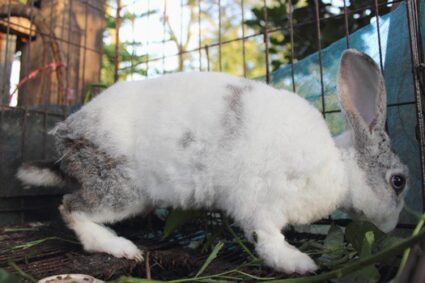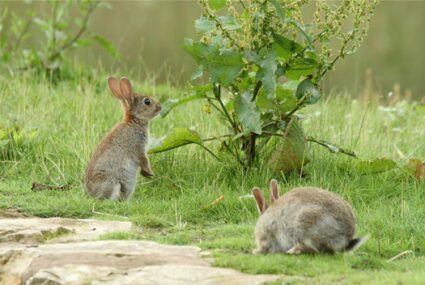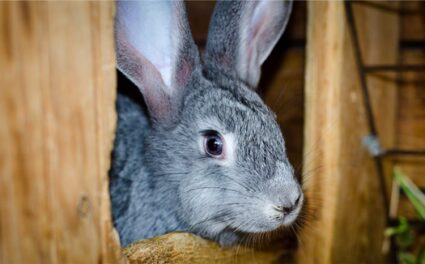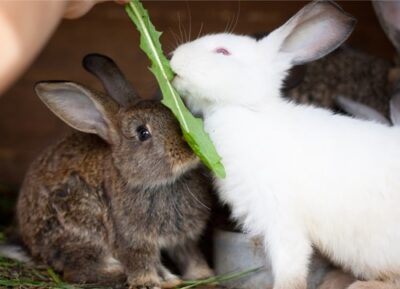When adopting a pet, you should always take into account how long the animal will live. Domestic rabbits can live for many years, provided they’re properly looked after. Certain breeds of rabbit will live longer than others.
Wild European rabbits live for 1 to 2 years. But pet rabbits live longer as they aren’t at risk from predators or disease. Well-cared-for, medium-sized rabbits can live for 10 years. Larger rabbits, such as Flemish giants, usually don’t live past 8 or 9. Dwarf rabbits, like Holland lops, may reach 12 years.
We’ll explore how long rabbits live on average, and what factors can affect their lifespan. We’ll then look at the lifespans of 20 popular rabbit breeds, and explain why some breeds live longer than others. Finally, we’ll share some advice on how to extend the life expectancy of pet rabbits.
How Long Do Domestic Rabbits Live?
Rabbits are friendly, clean and loveable animals. If you’re planning to adopt a rabbit, you should be prepared for a commitment of many years. The lifespan of a domestic rabbit is around ten years.
But if you take proper care of your rabbit, they may live for longer than this. Mick, the oldest rabbit in the world according to Guinness World Records, turned 16 in February 2019.
Of course, not every pet rabbit will be as lucky as Mick. There are many factors which determine how long a pet rabbit might live. These are as follows:
- Diet. Healthy, balanced diets contribute immensely to rabbit longevity. Overweight and underweight rabbits are both likely to die younger than average.
- Breed. Some breeds of rabbit tend to live longer than others. This depends mainly on size, and the propensity of each breed to develop certain health problems.
- Environment. If your rabbit lives outdoors, it may fall victim to predators, such as foxes. Indoor rabbits, unless properly supervised, may chew through electric cables or eat poisonous houseplants.
- Exercise. Rabbits require a minimum of 3 hours of exercise per day. They need plenty of space and time to run around, or they’re at risk of developing health problems.
- Mental health. Rabbits are intelligent, social creatures. They require toys and socialization to keep their mind stimulated. Bored or lonely rabbits can become depressed, which may lead to self-destructive behaviors and premature death.
Take care of your rabbit, and they’re likely to be part of your family for a decade or more.
How Long Do Rabbits Live in the Wild?
Domestic rabbits are the same species as wild European rabbits (Oryctolagus cuniculus). However, rabbits in the wild don’t live for as long as their domesticated counterparts.
Usually, wild rabbits live for a year at the most. 2 years old is considered a great age for a wild rabbit. There are several reasons why wild rabbits die so young. These are as follows:
- Predators. Many animals hunt rabbits in the wild, such as foxes and eagles. When kept in captivity, the threat of predation is reduced or eliminated.
- Weather. Bad weather, such as extreme heat, wind, and snow can cause death in wild rabbits. They may develop heat stroke or hypothermia, for example.
- Injury. If a wild rabbit becomes wounded, it won’t receive veterinary care. If their injury doesn’t kill it, wounds can easily become infected. This almost always leads to death.
- Disease and illness. Wild rabbits are prone to diseases such as myxomatosis. Illnesses and diseases are almost always fatal. There is no medical care, and weak rabbits are often picked out by predators.
- Poor nutrition. We have the opportunity to feed our pet rabbits healthy, balanced diets. Wild rabbits may accidentally eat something poisonous, or not have access to enough food.
That’s why rabbits have evolved to breed so much and so early on in their lives. They must ensure that the next generation is born before they succumb to the perils of life outdoors.
What is the Rabbit Life Cycle?
The life cycle of the rabbit begins, as always, with pregnancy.
A female rabbit (doe) can become pregnant as early as three months old. For domestic rabbits, it’s recommended that they not get pregnant until the age of 6 months.
The doe remains pregnant for 28 to 35 days before giving birth. Depending on the breed, there may be up to fourteen young in a litter.
A newborn rabbit is helpless for the first two weeks of its life. It’s born hairless and blind, unable to fend for itself. But unlike many other animals, the young develop quickly and are soon able to fend for themselves.

It takes less than a month until a newborn rabbit can find its own food. Rabbits wean after three to four weeks. Once it can forage for its own food, a rabbit can fend for itself. But it will still live with the rest of its family in the same warren.
Between 3 and 6 months old, a rabbit reaches sexual maturity. Females can then give birth within a month, as the previous generation did.
In that same breeding season, the female will go on to have many more litters. Some breeds can have up to 100 young in a season.
The lifespan of Different Rabbit Breeds
There are over 300 different breeds of domestic rabbit. All pet rabbit breeds are same species, and are all descended from wild European rabbits.
However, there are many physical differences between each breed. These differences can result in varying lifespans for each breed.
Below is a table briefly detailing the lifespan for 20 common rabbit breeds.
The middle column lists the average lifespan for that breed. This figure assumes that the rabbit is neutered or spayed, healthy and well-cared for. In the third column, we have provided each breed’s maximum known lifespan.
| Rabbit Breed | Average Lifespan | Maximum Lifespan (Approx.) |
|---|---|---|
| Lionhead | 7 – 9 years | 12 years |
| Standard Rex | 6 – 8 years | 10 years |
| Mini Rex | 8 – 10 years | 15 years |
| French Lop | 6 – 8 years | 10 years |
| Holland Lop | 8 – 10 years | 14 years |
| Netherland Dwarf | 7 – 10 years | 14 years |
| Dutch | 5 – 8 years | 12 years |
| English Angora | 7 – 10 years | 12 years |
| Mini Lop | 6 – 9 years | 12 years |
| Flemish Giant | 5 – 8 years | 10 years |
| English Lop | 5 – 7 years | 10 years |
| Harlequin | 5 – 8 years | 12 years |
| Continental Giant | 4 – 7 years | 9 years |
| New Zealand | 5 – 7 years | 10 years |
| American Fuzzy Lop | 5 – 8 years | 12 years |
| Chinchilla | 7 – 10 years | 12 years |
| American Sable | 5 – 8 years | 10 years |
| Himalayan | 7 – 9 years | 10 years |
| English Spot | 6 – 8 years | 10 years |
| Checkered Giant | 6 – 9 years | 10 years |
These are only estimates, not strict rules. The lifespan of a rabbit depends on how well you care for it. A Flemish giant could live for longer than a Netherland dwarf, for example.
What Factors Affect Rabbit Breed Life Expectancy?
There are many reasons why different rabbit breeds may live longer or shorter lives than others:
- Size. Larger rabbit breeds do not live as long as smaller rabbits. Scientists believe that larger breeds age quicker than smaller ones, but it’s not known precisely why.
- Care requirements. Because of their different physical characteristics, some rabbit breeds need more involved care. If this isn’t provided, they can become sick. For example, longhaired breeds are prone to hairballs if not brushed regularly.
- Health problems. Rabbit breeds are the result of artificial selection. Unfortunately, this has made some breeds prone to health problems. For example, lop-eared breeds are more prone to ear problems.
- Breed origin. Most rabbit breeds were bred to be pets. However, some breeds were originally bred for meat, such as Flemish Giants and New Zealand whites. Meat rabbits don’t need to live long, for obvious reasons.
- Genetic abnormalities. The gene pool for some rabbits, especially newer breeds, isn’t large. According to the Journal of Heredity, inbreeding in rabbits can cause genetic abnormalities that may reduce their lifespan.
We’ll now take a closer look at some of the most popular rabbit breeds. We’ll discuss their lifespans, and why each one lives for as long as it does.
How Long Do Lionhead Rabbits Live?
Lionhead rabbits are a small breed, weighing about 3lbs as adults. Because of their small size, Lionhead rabbits typically live for longer than large and giant breeds. However, they do have some specific requirements that can make them a challenge to care for.
Lionheads have long fur around their necks, which is where their name comes from. This fur must be brushed every day. If you don’t, your Lionhead could ingest its own hair while grooming, leading to hairballs. Hairballs can be fatal.
Their average lifespan of a Lionhead rabbit is between 7 and 10 years, provided they’re well cared for. But yours could live longer. Some Lionheads have been known to reach 12 years.

How Long Do Rex Rabbits Live?
There are two different breeds of Rex rabbit. One is the Standard Rex, which can reach 6 to 10lbs as an adult. The Mini Rex is much smaller, at 3.5 to 4.5lbs. The distinguishing characteristic of both breeds is soft, dense, velvety fur which doesn’t require grooming.
Standard Rex rabbits are one of the largest non-giant breeds. Because of this, they have a shorter lifespan than other breeds. They typically live for 6 to 8 years. However, some individuals have reached 10 years.
Mini Rex rabbits, being smaller, tend to live longer. They tend to live 8 to 10 years as standard. In exceptional cases, they may live as long as 15 years. Neither type of Rex is prone to any breed-specific health problems.
How Long Do Dutch Rabbits Live?
Dutch rabbits are a small to medium breed. They usually reach about 4.5 lbs as adults, and are one of the most popular breeds of rabbit.
They’re short-haired, so you don’t often need to groom them. But unfortunately, Dutch rabbits are prone to certain health conditions that can affect their lifespan.
- Uterine cancer. All unspayed female rabbits are at risk of uterine cancer, but Dutch does are particularly prone to it.
- Dental disorders. Dutch rabbits’ jaws are long, but their heads are small. This can result in dental misalignment and uneven tooth wear.
- Respiratory conditions, such as sinus infections and snuffles.
The average Dutch rabbit will live between 5 and 8 years. If spayed/neutered and taken good care of, they may live much longer. Many Dutch rabbits reach age 10; rarely, they can reach age 12.
How Long Do Lop Rabbits Live?
Lop rabbits, or lop-eared rabbits, is an umbrella term describing any rabbit breed with floppy ears. There are many lop breeds, including English Lops, French Lops, Holland Lops, Mini Lops, and American Fuzzy Lops.
All lop rabbits are prone to problems caused by their floppy ears. They’re susceptible to infections of the middle ear. This is because their folded ears tend to accumulate dirt, and inhibit the flow of air. Untreated ear infections can spread to the respiratory tract, and become dangerous.
As with all rabbit breeds, larger lops don’t live as long as smaller ones. French and English lops usually don’t reach 10 years of age. But Holland lops and mini lop rabbits can reach 12 to 14 years in exceptional circumstances.
How Long Do Angora Rabbits Live?
There are many breeds of Angora rabbit, but the most common is the English Angora. They’re medium-sized rabbits, known for their long, wool-like coats. Angoras are often kept for their wool, which can be spun into clothing.
As you might suspect, their coat can cause them problems. Angora rabbits are prone to a condition called wool block. This is where wool can gather in the stomach and block the gastrointestinal tract. It can be fatal.
To avoid this, Angora rabbits must be brushed extensively every day to remove all loose wool. If cared for adequately, Angora rabbits can live up to 12 years, though 10 is more common.
How Long Do Netherland Dwarf Rabbits Live?
Netherland Dwarf rabbits make popular pets. As their name suggests, they remain small throughout their lives, rarely exceeding 2.5lbs in weight.
The reason they are called dwarfs is they have a genetic disorder called dwarfism. This not only gives them their small size, but also small ears and a short skull.
Because of this, Netherland Dwarf rabbits are prone to jaw, dental, and respiratory conditions. And because they’re so small, their bones are extremely fragile. If dropped, their bones are easily broken.
However, despite their health problems, Netherland Dwarfs are one of the longest-lived rabbit breeds. They commonly reach 10 years of age, and some Netherland dwarfs have lived to 14.
How Long Do Giant Rabbits Live?
There are several breeds of giant rabbit. The three most common types are Flemish Giants, Checkered Giants, and Continental Giants. Of these, Checkered Giants are the smallest, weighing around 13 – 15lbs. Flemish and Continental Giant rabbits can each weigh over 20 pounds when fully grown.
Giant rabbits need a lot of space. They are prone to arthritis as they age, as their weight takes its toll on their skeletons. Other than this, they aren’t prone to any breed-specific problems.
Because of their large size, giant rabbits don’t live as long as other breeds. Most giant rabbits live between 4 and 8 years. Rarely, they have been known to reach 10 years of age.
Of course, the breed isn’t everything. Two rabbits of the same breed may reach totally different ages, depending on their environment and care.
How to Prolong Your Rabbit’s Life
The lifespan of your rabbit is far from set in stone. As their owner, there are steps you can take to help your rabbit live longer.
You won’t be able to solve all possible health problems that your rabbit may encounter. But by treating them well, and providing proper care, you’ll reduce the chance of illness and injury.
Keep Your Rabbit Safe Outside and Inside
This first step is common sense. If there are any threats you can identify, keep them away from your rabbit. If your rabbit lives outdoors, ensure their enclosure is predator-proof. Their hutch should also keep them warm in the winter, and cool in the summer.
For indoor rabbits, your home should be thoroughly rabbit-proofed. Anything unsafe to chew, such as electrical cables and houseplants, should be out of your rabbit’s reach.
If you have children, teach them how to interact with your rabbit correctly. They should know not to pick rabbits up, as this may cause injury.
Any other pets must be kept away from your rabbit at all times. Dogs and cats can be trained to stay away from rabbits, but it doesn’t always work.
Visit the Vet Regularly
Many first-time rabbit owners assume that you only need to take your rabbit to the vet when it’s sick. Of course, you should; but you should also take them when they’re well. Regular checkups are essential to keep your rabbit healthy and happy.
This is because the vet may identify things that are wrong with your pet before you’ve noticed them. Examples include:
- Overgrown teeth, which you may not notice
- Tumors
- The early signs of myxomatosis or other diseases
Bear in mind that not all veterinarians are experienced with rabbits. Before adopting a rabbit, ensure that there is a rabbit-savvy vet in your area.

Feed Your Pet the Proper Rabbit Diet
The optimal rabbit diet includes hay, pellets, and a small amount of fresh vegetables.
The rabbit’s digestive system is set up to process the fiber in grass efficiently. This means they need to eat lots of grass hay, like orchard or timothy hay. Hay should make up 85% of the diet.
Most owners also feed their rabbit hay pellets. Pellets are not strictly necessary, but they can be a good source of fiber, particularly if your rabbit is fussy about hay. You should also feed your rabbit some leafy greens and vegetables per day. Fruit should only be fed as a treat.
By feeding your rabbit a poor diet, it can become overweight or undernourished. The wrong diet can also cause digestive problems, which may lead to gastrointestinal stasis and death.
Neuter or Spay Your Rabbit
Neutering or spaying your rabbit the most important thing you can do to increase your rabbit’s lifespan. In male rabbits, neutering involves removing the testicles, which are the main source of the hormone testosterone.
Neutered male rabbits are calmer and less aggressive, leading to a less stressful life. Stress can put a strain on a rabbit’s heart, and cause health problems. So, neutered rabbits tend to live longer.
Spaying is the operation performed on female rabbits. It involves the removal of the uterus and ovaries. Rabbits are prone to uterine cancer, and spaying your rabbit eliminates the risk. Ovarian cancer is a risk, too. A study in the Journal of Veterinary Medical Science found ovarian lesions in 27% of rabbits.
Female rabbits should be spayed when they become sexually mature, around 5 months of age. Males can be neutered as soon as their testicles descend at 8-12 weeks.
How long do unspayed rabbits live? Around 80% of unspayed female rabbits develop uterine cancer by the age of 6. It’s almost always fatal, as it’s not often detected until it’s too late to operate.
Exercise and Entertainment
Enrichment refers to anything that makes your rabbit’s life more interesting. Toys, exploration, socialization, and one-on-one play are all forms of enrichment.
One simple way of enriching your rabbit’s life is to increase the time it spends exercising. Allow it to explore your home, as long as it’s rabbit-proofed.
If you have a yard, you might set up a run or pen to allow your rabbit time outdoors. Keeping fit is essential for any animal, so exercise will keep your rabbit healthy and alive for longer. Toys are also vital for your rabbit’s mental health. Examples of rabbit toys include:
- Hollow tubes that your rabbit can scamper through
- Cardboard boxes that your rabbit can sit inside or have fun destroying
- Balls that your rabbit can chase
- Wooden toys to chew
Rabbits are intelligent creatures, and need lots of mental stimulation to avoid boredom and depression.
Spending a lot of time with your rabbit will help prolong its life, too. Rabbits are social animals and enjoy the company of people, and other rabbits. Affection and play make your rabbit happy, which again will help it live longer.
Why Do Rabbits Have Such a Short Lifespan?
Even when kept in captivity, rabbits have a short lifespan of 8 to 10 years on average. Though this is much longer than small animals, like hamsters, it’s shorter than many other pets, like cats.
The lifespan of an animal is related to the age during which it can successfully breed. Once an animal has had many offspring, its life has been fulfilled, from an evolutionary point of view.
Rabbits have evolved to breed early in life. They also have large litters to compensate for the many rabbits that become prey to other animals. These traits were selected by evolution because they help rabbits survive in the wild.
But what isn’t selected for is how successfully an animal can survive in old age. Once an animal reaches old age, it can’t breed to pass on its genes. As rabbits have so many litters within the first few years, they don’t pass on genes that help them live longer.
But it’s still a privilege to be able to share a decade of life with a beloved pet. Even if your rabbit doesn’t live as long as you’d like, they’ll enrich your life in so many ways.

